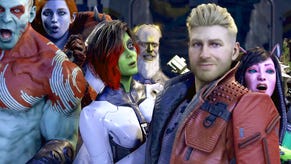Marvel's Guardians of the Galaxy: an excellent game - but 60fps comes at a cost
PlayStation 5 and Xbox Series consoles tested.
Developer Eidos Montreal's take on Marvel's Guardians of the Galaxy brings us one of the very best story-driven games of 2021 - and it's great to see Square-Enix pivot back firmly to a single-player action game. There's no multiplayer, no online, not even co-op - and refreshingly, there's not the slightest hint of the 'games as a service' concept that sat so uneasily with Marvel's Avengers. It's all about you, playing as Peter Quill aka Star-Lord, haphazardly adventuring through a well-scripted story, chapter by chapter. Based on the Dawn Engine, as used in Deus Ex Mankind Divided, Guardians of the Galaxy is a genuine treat, but how does it play out on the new wave of consoles?
First off, I really want to stress that Guardians of the Galaxy is a genuine surprise, an exceptional game and a visual tour-de-force. It often looks stunning - and that starts with the locations. The Quarantine Zone, a planet of derelict machinery fused with a pink crystalline gel, is a perfect backdrop for the Guardians' first mission. Materials come out beautifully in the midday sun. Light shafts seep from behind pillars of dense scrapyard tech, giving the world a rich, opulent look. Lighting also brings out the sharp, specular layer on the pink rubble, a lot of which is destructible. All round, there's a heavy art-driven approach to each area and every set-piece. Later planets have wildly different biomes, of course. The second mission puts us under rainy, scorched skies, for example, while wind physics affect foliage. It's a battle against the elements as we hop between moss-covered islands - where again, material work is stand-out.
In short, the game looks very good. Extremely good in fact, marred only by a slight lack of polish. For example, you can't overlook some bugs that have crept in at launch. These include obvious streaming stutters, notably while flying into the first planet. There are lighting quirks during camera transitions, as the buffer fades in and out across characters. Animations snap awkwardly while crawling, or climbing over objects too. All combined, these quirks distract a little from the strong production values of the rest of the package. Patches were rolling out even during the process of reviewing the game, so maybe we'll see some improvement - and hopefully that will extend to an uneven performance mode found in the Series X and PS5 versions of the game.
As things stand, PS5 and Xbox Series X are practically identical in visual settings: in foliage quality, effects, shadows - they're closely matched. Each has an identical set of modes too. The quality mode runs at 3840x2160 on PS5 and Series X, capped at 30 frames per second. Temporal anti-aliasing is used on each, and it's the premier way to enjoy the games visuals. There's a chance of dynamic resolution scaling here too. However, every pixel count returns a native 4K on this mode. Next up is the performance mode. This targets a native 1920x1080 to sustain a smoother 60fps on PS5 and Series X. That's quarter of the overall pixel count of 4K, in order to double the frame-rate.
Needless to say, the divide in image quality between the two modes is stark. Yes you can play at a target of 60fps - and for playability it's a great way to enjoy the game's combat, but the cost to image quality is difficult to ignore. This is of course solved in the 4K 30fps quality mode, where everything becomes pin sharp; a problem fixed by brute force of using more pixels. Quality mode also delivers higher quality textures, improved texture filtering and - while subtle - more refined ambient occlusion. Geometry LODs also are much improved, meaning that pop-in is less obvious. Elsewhere, shadow draw and foliage density are boosted in quality mode too. It's so much more than a resolution bump. If 4K and 30fps is the way the game was meant to be seen - to be enjoyed in the cinematic sense - then 1080p at 60fps is arguably how it's best played.

Xbox Series S does not fare as well, unfortunately. The higher frame-rate 60fps option is missing, leaving you with a 1080p30 mode that also sees degraded grass density and more noticeable LOD pop-in. Judged on its own merits, the game is still compelling, but the cutbacks up against Series X and PlayStation 5 are numerous, so it really pays off to play on higher end hardware. The problem is that while the more capable machines do possess a 60fps mode, there are issues - even with the 1080p resolution cut. Both PS5 and Series X cannot lock to 60fps, with drops into the low 50s and even the high 40s during combat and other alpha-heavy moments. Series X seems to have fewer drops than PS5, but it's surprising to see these issues at all when resolution has been cut back so dramatically. The 4K quality mode makes a better fist of sticking to its 30fps target, though occasional single frame hitches in cutscenes or when issuing orders to the other Guardians are present.
I went into this one unsure what to expect but after spending some time with the game, I expect Guardians of the Galaxy to feature in plenty of GOTY lists by the year's end - it's that good, even with the technical drawbacks I've outlined. It's captivating visually, the character dialogue is well-written and there's plenty of depth to explore in its combat. However, there's a lingering sense the project needed just a little more time to address its bugs (ranging from dodgy audio to a boss attacking me with limbs I'd already hacked off), hitches and performance bottlenecks. Fingers crossed that Eidos Montreal will continue to patch and improve the game - and I really hope that they do because at its core, Guardians of the Galaxy is a surprise triumph that I hope gets the attention that it deserves - it's up there with the best superhero games we've seen in recent years.










